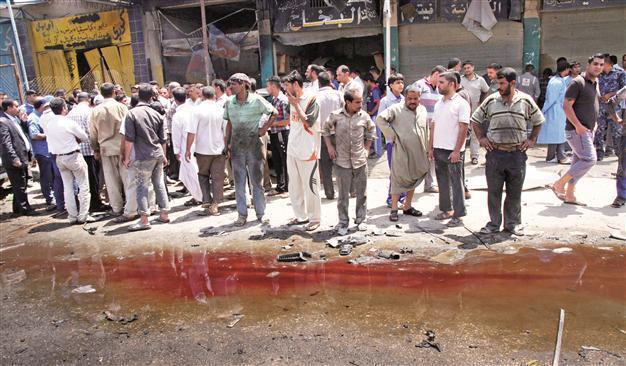April deadliest month for Iraq since 2008: UN
BAGHDAD

Residents look at a pool of blood after a bomb attack. The UN report raised fears of a return to a sectarian conflict that took the lives of tens of thousands from 2006 to 2008. REUTERS photo
April was Iraq’s deadliest month in nearly five years, the United Nations said yesterday, with more than 700 people killed in violence.
“The month of April was the deadliest since June 2008. A total of 712 people were killed and another 1,633 were wounded in acts of terrorism and acts of violence,” a statement from the U.N. mission in Iraq said. “Baghdad was the worst-affected governorate, with a total of 697 civilian casualties (211 killed, 486 injured), followed by Diyala, Salaheddin, Kirkuk, Nineveh and Anbar,” the statement said.
A wave of violence began on April 23 when security forces moved on Sunni anti-government protesters near the town of Hawijah in north Iraq, sparking clashes in which 53 people were killed. Dozens more died in subsequent unrest, including in revenge attacks targeting security forces in Kirkuk, Nineveh, Diyala, and Anbar provinces, raising fears of a return to the all-out sectarian conflict that took the lives of tens of thousands of people from 2006 to 2008.
The late-April violence was the deadliest so far linked to protests that broke out in Sunni areas of Shiite-majority Iraq more than four months ago. The Sunni protesters have called for the resignation of Prime Minister Nouri al-Maliki, a Shiite, and criticized authorities for allegedly targeting their community with wrongful detentions and accusations of involvement in terrorism.
“Conditions have definitely worsened in the country,” said John Drake, an Iraq specialist with risk consulting firm AKE Group. “If the government fails to contain the unrest and address some of the grievances of the protesters, the momentum could certainly build and lead to a re-emergence of widespread violence.”
June 2008, when the U.N. said Iraq last saw violence at the current level, was one month before the departure of the last of five brigades sent to Iraq as part of a “surge” of troops. The additional troops, combined with Sunni tribes who turned against al-Qaeda and joined forces with the United States, helped to bring violence under a semblance of control, but political reconciliation, the strategic objective of the surge, has yet to be realized.
Kurdish ministers back to BaghdadPowerful Shiite cleric Moqtada al-Sadr’s order in August 2008 for his Mahdi Army militia to suspend its activities indefinitely also helped to reduce unrest. But while violence has fallen from its peak at the height of Iraq’s sectarian conflict in 2006 and 2007, attacks on both civilians and security forces remain common.
Meanwhile, Iraqi Kurdish ministers and lawmakers will end boycotts of Parliament and the Cabinet begun in March, the Kurdistan Regional Government (KRG) prime minister said May 1. A meeting that included Kurdish political parties “decided to return the Kurdish ministers and representatives to Baghdad... and participate in sessions of the Iraqi Cabinet and Parliament,” Nechirvan Barzani told a news conference in Arbil.
The boycotts began in March after Kurds objected that the new federal budget did not allocate enough money to pay foreign oil companies working in the region. The administration has signed oil contracts with various foreign firms without the approval of Baghdad, and complains that the federal government has not paid money owed to them. For its part, Baghdad regards as illegal all contracts not made by the federal government.
